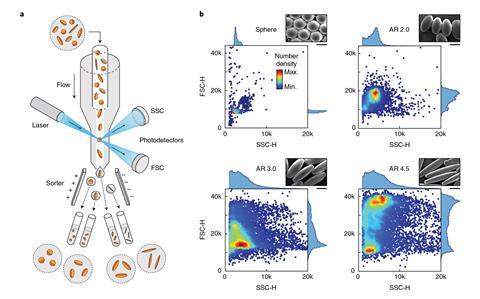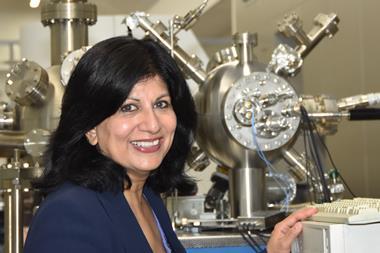Cell sorting machine discriminates between spherical, disc-shaped and ellipsoidal polystyrene particles
Scientists can now separate polymer particles solely by their shape – which is tricky when the particles are only a few micrometres in size – using a cell-sorting instrument.
A colloid’s properties depend on the type, size and shape of the particles it is made of. Centrifugation or electrophoresis can separate particles by size, but shape sorting is more difficult. A few specialised techniques exist, but they are limited to – and always specially designed for – only a few particle shapes.
Now, a US research team has now adopted the fluorescence-activated cell sorter, a piece of equipment well known to biologists, for chemical means. The instrument detects cells tagged with fluorescent markers, but the chemists discovered that the same machine can also separate polystyrene particles by shape. Unlike cells, the beads don’t need to be modified in any way before they can be run through the sorter.
Even very similarly-shaped particles – spheres, discs, ellipsoids and elongated ellipsoids – can be sorted to purities of more than 95%. The particles’ identical density, mass and volume make them almost impossible to separate by traditional means. But the shape sorting relies on the particles’ different light-scattering properties.

In fluorescence-activated cell sorting, a suspension is broken up into droplets, each containing a single particle. The droplets then pass through a laser beam coupled with two photodetectors. Usually, the detectors scan for fluorescence. But the US team created light scattering maps that work like fingerprints for different particle shapes, even accounting for particles passing through the laser in different orientations.
As different scattering patterns are detected, they trigger an electrostatic deflection system. It gives each droplet a positive or negative charge and directs it into a separate container.
The chemists used their method on particles of very different sizes, from 500nm to 20μm, and on various polymer types like acrylic. Since the sorter can handle 107 particles per hour – approximately 2mg of 6μm polystyrene balls – the team thinks it is suitable for both research and small scale-up projects.
References
P L Mage et al, Nat. Mater., 2019, 18, 82 (DOI: 10.1038/s41563-018-0244-9)

















No comments yet